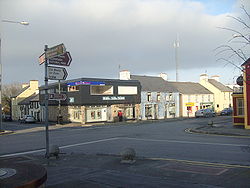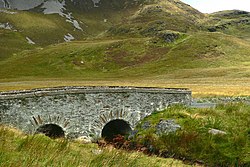Falcarragh
| An Fál Carrach Irish: Falcarragh | |
| County Donegal | |
|---|---|
 The crossroads on Main Street | |
| Location | |
| Grid reference: | B952329 |
| Location: | 55°8’11"N, 8°6’18"W |
| Data | |
| Population: | 764 (2016) |
| Dialling code: | 074 |
| Local Government | |
| Dáil constituency: |
Donegal |
Falcarragh is a Gaeltacht village and townland in the north-west of County Donegal. The settlement is in the old parish of Cloughaneely.
Officialdom has decreed that the village's sole official name is the Irish form An Fál Carrach, though it is also rendered as Na Crois Bhealaí ("the crossroads").
According to the 2016 census, of the 1,329 people over the age of 3 living in Na Crios Bhealaí electoral division 70% of the population are able to speak Irish while 34% claim to speak the language on a daily basis outside the education system.
Name
The name Falcarragh is from the Irish An Fál Carrach, meaning 'The Wall of Stone' or 'stone boundary'. The name has been used since 1850, ascribed so by John O'Donovan as he believed 'Na Crois Bhealaí', 'the Cross Roads', was too common in Ireland to allow distinction. Na Crois Bhealaí is still used by native speakers when referring to the town and on some maps it shows up as 'Crossroads'. Older maps refer to it as Robinson's Town. The new 'official' name, An Fál Carrach, originally referred to a little hamlet south-east of the present town, at the foot of Falcarragh hill - but gradually houses were built at the crossroads, mainly for the workers and tradespeople employed on the Olphert Estate in Ballyconnell.
History


The first recorded reference to Falcarragh appears in a report written by William Wilson, Raphoe in 1822. Wilson was the Protestant Bishop’s steward responsible for the collection of tithes to support the Protestant clergy. He, apparently, received a hostile reception on arrival in Cloughaneely (parish) according to his account to the bishop:
- According to my intention I went to Cloughineely and on Monday about 12 o’clock arrived at a place called Falcarrow in your Lordship’s See (about five miles distant from Dunfanaghy) where I then, pursuant to advertisement, proposed holding the Court as I twice before had, but was immediately on my arrival surrounded by upwards of 150 to 300 men who had assembled merely for the purpose of preventing me from holding any Court and threatened my life if I would. Their measures I was obliged to comply with.
By the village, the bridge over a small burn here is known as the Bridge of Tears. In the days when many were driven to emigrate, family and friends of emigrants would accompany them as far as the bridge before saying goodbye, while the emigrants would continue on to the port at Londonderry.
Slater’s Directory of 1870 provides us with valuable information about Falcarragh and its surrounding area:
- Crossroads or Falcarragh, is a village, in the parish of Tullaghbegley, and partly of Raymunterdoney, barony of Kilmacrennan, situated on the summit of a small hill near to the coast; opposite here is the Island of Torrey, nine miles distant. The places of worship are the parish church and a Presbyterian meetinghouse. A dispensary and a school are the charitable institutions. Fairs are held on the last Thursday monthly. Population in 1861 was 231.
Slater's Directory of 1881 records that the population increased to 258 inhabitants in 1871 and also tells that there was a Protestant Episcopal Church in the town. We are given some information about the local post office situated at the crossroads. Thomas Browne was Postmaster at the time and “letters from all parts arrive at ten minutes past eleven morning, and are dispatched at one afternoon.”

From 1622 to 1921, the Olpherts were the main landlords in the district, Sir John Olphert, the last Olphert landlord, died in 1917.
The tallest Celtic cross in Ireland is located near Falcarragh.